|
Personal Equipment of the
Schutztruppe
|
|
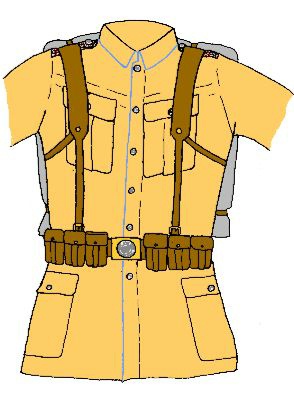 |
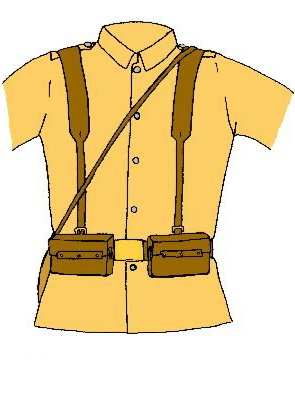 |
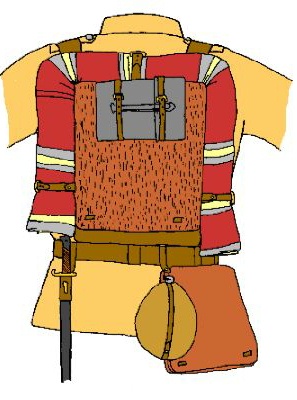 |
|
Figure 1
M1909 Equipment |
Figure 2
M1898 Equipment |
Figure 3
Rear of Equipment |
Figure 1 shows the 1909 standard issue other ranks equipment as worn
by a German other ranks trooper of the Schutztruppe in Africa. This equipment was
standard issue to the in Cameroon, Togo, Tsingtao and to
European and some askari units in East Africa by 1914. It included six
ammunition pouches held together in two groups of three. Each pouch held 15 rounds
(three clips of five rounds), although a cavalry version was also
sometimes issued which was smaller and held only 10 rounds per pouch.
Occasionally single 10 round pouches were issued, mainly to officers.
Leather straps over and under the shoulders carried a rucksack (see figure
3) and also served to support the ammunition pouches. The belt was clasped
with a brass belt buckle bearing the imperial crown (see right). As was
standard in the German army of 1914 all equipment was issued in brown
leather. Unlike the German forces in Europe who were ordered to
blacken their equipment in 1915 the colonial troops continued to use
brown leather. Confusingly most German naval troops or landing parties
wore black leather equipment, except the III. Seebatallion who wore
brown for the tropical climate in which they served. |
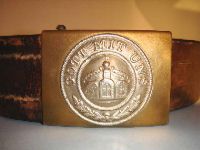
German Schutztruppe Belt Buckle
(See
Belt Buckles
Details Page)
Photo Copyright Damien Doppler |
Figure 2 shows the old issue 1895 standard issue other ranks
equipment as worn by an East African askari. The German Colonial and
Naval forces defending the colonies were normally issued with standard
German Imperial Army personal equipment, although sometimes slightly
outdated. This equipment was still in use by most of the East African
askaris and the New Guinea police. It was also often issued to
reservists and auxiliary forces in other colonies. Each large
ammunition pouch held 45 rounds. Again cavalry versions were issued
holding only 30 rounds each. In this figure the back pack is not worn
and so neither are the under arm straps. The shoulder straps were
however often kept without the back pack to support the ammunition
pouches. They met on the back in a Y configuration. Another strap
across the chest is used to carry the bread bag or water
bottle. Askari belt buckles were plain brass (see right). |
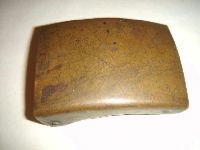
Askari Belt Buckle
(See
Belt Buckles
Details Page)
Photo Copyright Damien Doppler |
|
Figure 3 shows other ranks equipment in Marching
order from the rear as worn by an East African askari. He carries the 1895
model leather backpack with hide flap, upon which is strapped his canteen.
Around the backpack should have been his tent section or issue blanket but
this askari, like others seen in photographs and contemporary
illustrations has a locally made patterned blanket instead. On his left
hip attached to the belt is the 1905 model bayonet, while on his right hip
is his bread bag and water bottle. The water bottle was of course an
essential item in the African campaigns and soldiers sometimes carried
more than one of them. The main differences between the what was carried
by the Imperial army in Europe and the askaris in East Africa are that the
askaris rarely carried entrenching tools or greatcoats.
In action or where porters were available
to carry additional equipment askaris were usually more lightly equipped.
The back pack was the first item to be discarded, with askaris seen often
with just ammunition pouches, bayonets, rolled blankets and water bottles. |
Mounted Equipment. A unique style mounted personal equipment was worn by the
German South West African Schutztruppe (see right).
The equipment itself consisted of a leather harness complete with 12
ammunition pouches, each with a strap holding down the pouch flap, stretching around the rear and buckled there. On the
left hip was riveted a bayonet holder and on the right, a brass loop to
attach a water bottle.
Because this equipment was designed for mounted troops where the horse
could carry much of the load, no provision was made for back packs, tent
sections, blankets, canteens or bread bags.This equipment was also worn by mounted personnel in
the Cameroon, although in a slightly different fashion with the
straps crossing over the chest as well as the back.
|
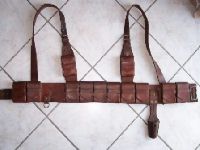
SW African Mounted Equipment
(See
Mounted Equipment
Details Page)
Photo from an Anonymous Collector |
| |
|
|
Under wartime conditions many variations
were seen. Privately purchased items were often in use along with a variety of
native, civilian, hunting, homemade and captured allied items especially in East
Africa towards the end of the war. Thanks
to Peter Ellis of Leather Rebels Belts for his expert help on this
page. |
|
|
|
Please email me
here if you have more information or photos on this topic.
Back to Main Menu for German
Colonial Uniforms
|
|